The Treasure of El Carambolo, discovered in 1958 near Seville, Spain, is one of the most significant finds of Iberian Peninsula archaeology. Dating back to around 800-700 BC, this remarkable collection of gold artifacts has raised questions about the interactions between the Tartessos culture and the Phoenicians. Its discovery has provided vital insights into the cultural, economic, and political networks that connected ancient societies in the western Mediterranean.
Get your dose of History via Email
Discovery and Composition of the Treasure
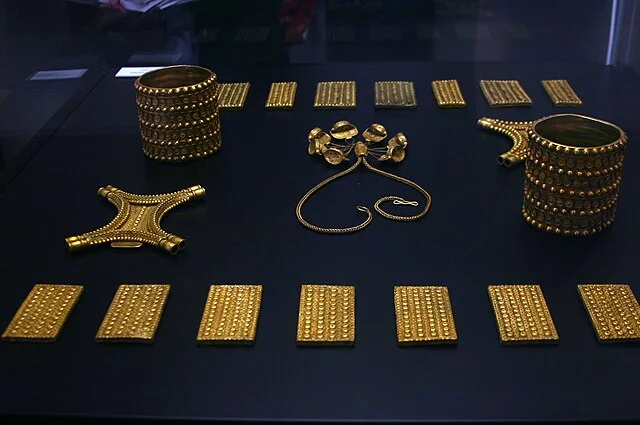
On September 30, 1958, workers constructing a gun club in the village of El Carambolo, just outside Seville, unearthed an extraordinary treasure. Archaeologist Juan de Mata Carriazo supervised the excavation, quickly recognizing the importance of the find. The hoard consists of 21 pieces of intricately crafted gold artifacts, weighing over two kilograms in total.
The collection includes a wide collar, two large pectorals, multiple bracelets, and several belt buckles, all made with refined craftsmanship. The artifacts are notable for their use of repoussé techniques, where designs were hammered into the metal to create raised patterns. This high level of craftsmanship indicates a skilled artisan familiar with both local and foreign metalworking traditions.
Tartessos and Phoenician Influence
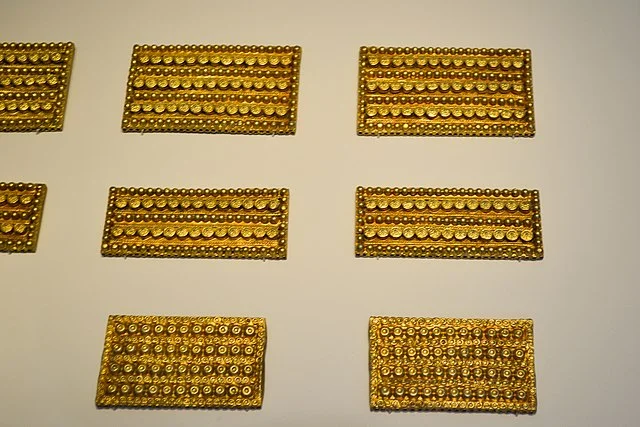
The discovery of the El Carambolo treasure has sparked considerable debate regarding its origin and cultural affiliation. Scholars have long associated the site with the Tartessos civilization, a pre-Roman Iberian culture known for its advanced metallurgy, thriving trade networks, and unique art forms. Based on literary and archaeological evidence, Tartessos is thought to have flourished between 1000 BC and 500 BC in southwestern Spain.
However, the treasure’s intricate design and use of gold suggest a strong Phoenician influence. The Phoenicians, who established colonies along the Iberian coast in the first millennium BC, brought with them advanced metalworking techniques and extensive trade connections. Many scholars argue that the El Carambolo treasure exemplifies a hybrid style, blending Tartessian motifs with Phoenician techniques. This interpretation implies that the Tartessos people adopted foreign elements to create distinct regional art forms that symbolized their identity and status.
Ritual and Religious Significance
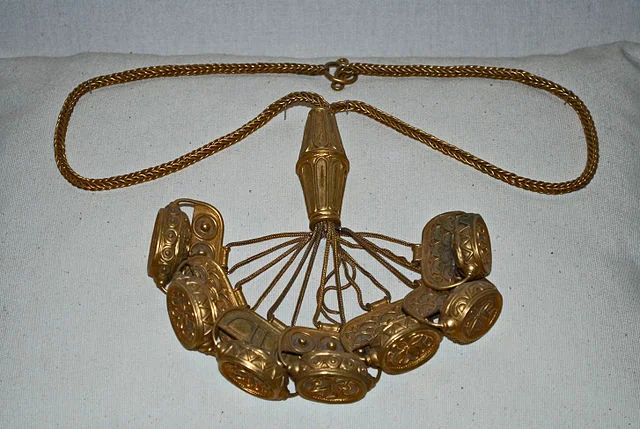
The function of the Treasure of El Carambolo remains a subject of speculation among archaeologists. Some scholars propose that the artifacts were ceremonial regalia worn by Tartessian elites or priest-kings. The elaborate collars and pectorals likely signified high status, suggesting the treasure may have played a role in religious or political ceremonies.
Excavations at the El Carambolo site revealed structural remains that hint at a possible temple complex dedicated to the Phoenician goddess Astarte. This finding has led some to propose that the treasure may have been an offering to a deity, emphasizing the importance of religion and ritual in Tartessian society. The proximity of Phoenician settlements would have facilitated religious and cultural exchanges, making it plausible that the Tartessos people incorporated Phoenician deities into their own belief systems.
Theories on Ownership and Usage
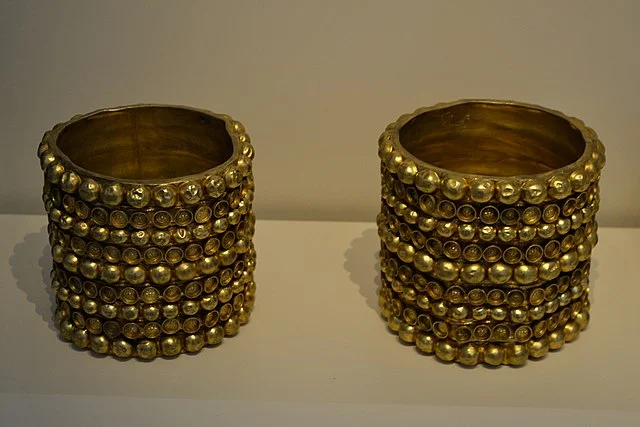
Various theories attempt to explain the ownership and usage of the El Carambolo treasure. One theory suggests that the treasure belonged to Tartessian elites who used it to assert their authority over local communities and to solidify alliances. Another theory posits that the treasure may have been a diplomatic gift from Phoenician traders or settlers to Tartessian leaders, symbolizing an alliance between the two cultures.
Additionally, some scholars believe that the treasure might have functioned as a religious deposit, hidden deliberately for protection during times of social upheaval. If the artifacts were intended as a votive offering, this would underscore the Tartessos culture’s spiritual connection to gold and its symbolism within their society.
Archaeological Importance and Debates
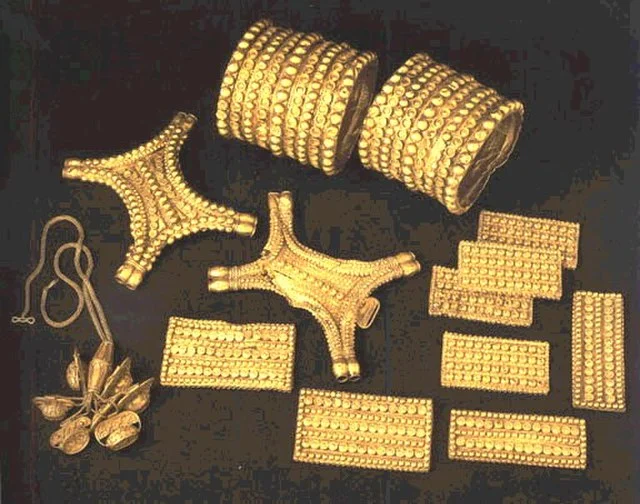
The Treasure of El Carambolo continues to hold a central place in the study of early Iberian civilizations, yet it also raises unresolved questions. Its precise dating, for example, has been a topic of ongoing research. Initially thought to date from around 700 BC, some researchers now argue for a broader chronological range based on stylistic and comparative analyses. The debate over its origins has also led to a re-evaluation of the relationships between indigenous Iberian societies and Phoenician colonizers.
In recent years, scholars have conducted additional excavations and analyses of the El Carambolo site, aiming to uncover more about the lifestyle and structure of Tartessian society. New findings may eventually clarify the treasure’s origin and purpose, providing further insight into the complex cultural dynamics of ancient Spain.
Legacy and Preservation

Today, the Treasure of El Carambolo remains a symbol of Spain’s ancient cultural heritage. Since its discovery, it has been displayed in various museums, with the Archaeological Museum of Seville currently housing the artifacts. The museum has made replicas available for public viewing, preserving the originals due to their historical and material value.
Efforts to protect and preserve the treasure highlight the challenges faced by archaeologists and conservators working with precious ancient artifacts. Through meticulous preservation, the treasure continues to serve as an invaluable educational resource, allowing modern audiences to explore and appreciate the artistry and complexity of Iberian Peninsula’s ancient cultures.
Conclusion
The Treasure of El Carambolo provides a rare glimpse into the cultural interactions between the Tartessos civilization and Phoenician settlers in ancient Iberia. Its exquisite craftsmanship and enigmatic origin have made it a focal point of Iberian archaeology, sparking discussions on issues of cultural exchange, identity, and religious practices. Future archaeological work may yet reveal further details, deepening our understanding of the social and political networks that shaped this vibrant region in antiquity.
Source:

